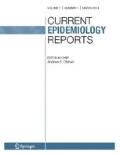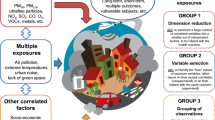Abstract
Purpose of This Review
This review provides a summary of statistical approaches that researchers can use to study environmental exposure mixtures. Two primary considerations are the form of the research question and the statistical tools best suited to address that question. Because the choice of statistical tools is not rigid, we make recommendations about when each tool may be most useful.
Recent Findings
When dimensionality is relatively low, some statistical tools yield easily interpretable estimates of effect (e.g., risk ratio, odds ratio) or intervention impacts. When dimensionality increases, it is often necessary to compromise this interpretablity in favor of identifying interesting statistical signals from noise; this requires applying statistical tools that are oriented more heavily towards dimension reduction via shrinkage and/or variable selection.
Summary
The study of complex exposure mixtures has prompted development of novel statistical methods. We suggest that further validation work would aid practicing researchers in choosing among existing and emerging statistical tools for studying exposure mixtures.
Similar content being viewed by others
References
Papers of particular interest, published recently, have been highlighted as: • Of importance •• Of major importance
Wild CP. Complementing the genome with an “exposome”: the outstanding challenge of environmental exposure measurement in molecular epidemiology. Cancer Epidemiol Biomark Prev. 2005;14(8):1847–50.
Wild CP. The exposome: from concept to utility. Int J Epidemiol. 2012;41(1):24–32.
•• Braun JM, et al. What can epidemiological studies tell us about the impact of chemical mixtures on human health? Environ Health Perspect. 2016;124(1):A6–9. Provides an overview of a recent NIEHS workshop and key areas of research interest.
Hamra GB, Guha N, Cohen A, Laden F, Raaschou-Nielsen O, Samet JM, et al. Outdoor particulate matter exposure and lung cancer: a systematic review and meta-analysis. Environ Health Perspect. 2014;122(9):906–11.
Chung Y, Dominici F, Wang Y, Coull BA, Bell ML. Associations between long-term exposure to chemical constituents of fine particulate matter (PM2.5) and mortality in Medicare enrollees in the eastern United States. Environ Health Perspect. 2015;123(5):467–74.
Howard GJ, Webster TF. Contrasting theories of interaction in epidemiology and toxicology. Environ Health Perspect. 2013;121(1):1–6.
Czarnota J, Gennings C, Wheeler DC. Assessment of weighted quantile sum regression for modeling chemical mixtures and cancer risk. Cancer Informat. 2015;14(Suppl 2):159–71.
Wolff MS, Engel SM, Berkowitz GS, Ye X, Silva MJ, Zhu C, et al. Prenatal phenol and phthalate exposures and birth outcomes. Environ Health Perspect. 2008;116(8):1092–7.
Varshavsky JR, Zota AR, Woodruff TJ. A novel method for calculating potency-weighted cumulative phthalates exposure with implications for identifying racial/ethnic disparities among U.S. reproductive-aged women in NHANES 2001-2012. Environ Sci Technol. 2016;50(19):10616–24.
VanderWeele TJ. On the distinction between interaction and effect modification. Epidemiology. 2009;20(6):863–71.
Bobb JF, Valeri L, Claus Henn B, Christiani DC, Wright RO, Mazumdar M, et al. Bayesian kernel machine regression for estimating the health effects of multi-pollutant mixtures. Biostatistics. 2015;16(3):493–508.
Hamra G, MacLehose R, Richardson D. Markov chain Monte Carlo: an introduction for epidemiologists. Int J Epidemiol. 2013;42(2):627–34.
MacLehose RF, Hamra GB. Applications of Bayesian methods to epidemiologic research. Curr Epidemiol Rep. 2014;1–7.
Gelman A, Hill J, Yajima M. Why we (usually) don’t have to worry about multiple comparisons. J Res Educ Effect. 2012;5(2):189–211.
MacLehose RF, Dunson DB, Herring AH, Hoppin JA. Bayesian methods for highly correlated exposure data. Epidemiology. 2007;18(2):199–207.
Hamra G, Richardson D, MacLehose R, Wing S. Integrating informative priors from experimental research with Bayesian methods: an example from radiation epidemiology. Epidemiology. 2013;24(1):90–5.
Hamra GB, et al. Lung cancer risk associated with regulated and unregulated chrysotile asbestos fibers. Epidemiology. 2016.
Wold H. Partial least squares. In: Encyclopedia of statistical sciences. Hoboken: John Wiley & Sons, Inc.; 2004.
Wold S, Sjostrom M, Eriksson L. PLS-regression: a basic tool of chemometrics. Chemom Intell Lab Syst. 2001;58(2):109–30.
Zou H, Hastie T. Regularization and variable selection via the elastic net. J.R. Statist Soc B. 2005;67(Part 2):301–20.
Li Q, Lin N. The Bayesian elastic net. Bayesian Anal. 2010;5(1):151–70.
Park T, Casella G. The Bayesian Lasso. J Am Stat Assoc. 2008;103(482):681–6.
Chadeau-Hyam M, Campanella G, Jombart T, Bottolo L, Portengen L, Vineis P, et al. Deciphering the complex: methodological overview of statistical models to derive OMICS-based biomarkers. Environ Mol Mutagen. 2013;54(7):542–57.
• Stafoggia M, et al. Statistical approaches to address multi-pollutant mixtures and multiplee: the state of the science. Curr Environ Health Rep. 2017;4(4):481–90. Provides an overview of methods that can be applied to higher dimensional mixtures problems, such as exposomics.
Ho TK. Random decision forests, in Proceedings of the Third International Conference on Document Analysis and Recognition (Volume 1—Volume 1). 1995; IEEE Computer Society. pp. 278.
Chipman HA, George EI, McCulloch RE. BART: Bayesian additive regression trees. Ann Appl Stat. 2010;4(1):266–98.
Breiman L. Bagging predictors. Mach Learn. 1996;24(2):123–40.
Freund Y and Schapire RE. Experiments with a new boosting algorithm, in Proceedings of the Thirteenth International Conference on International Conference on Machine Learning. 1996; Morgan Kaufmann Publishers Inc., Bari. pp. 148–156.
Valeri L, et al. The joint effect of prenatal exposure to metal mixtures on neurodevelopmental outcomes at 20–40 months of age: evidence from Rural Bangladesh. Environ Health Perspect. 2017;125(6):067015.
Herring AH. Nonparametric bayes shrinkage for assessing exposures to mixtures subject to limits of detection. Epidemiology. 2010;21(Suppl 4):S71–6.
Lenters V, Portengen L, Rignell-Hydbom A, Jönsson BA, Lindh CH, Piersma AH, et al. Prenatal phthalate, perfluoroalkyl acid, and organochlorine exposures and term birth weight in three birth cohorts: multi-pollutant models based on elastic net regression. Environ Health Perspect. 2016;124(3):365–72.
Liaw A, Wiener M. Classification and regression by randomForest. R News. 2002;2(3):18–22.
Agay-Shay K, Martinez D, Valvi D, Garcia-Esteban R, Basagaña X, Robinson O, et al. Exposure to endocrine-disrupting chemicals during pregnancy and weight at 7 years of age: a multi-pollutant approach. Environ Health Perspect. 2015;123(10):1030–7.
Austin E, Coull B, Thomas D, Koutrakis P. A framework for identifying distinct multipollutant profiles in air pollution data. Environ Int. 2012;45:112–21.
Milligan GW. Cluster analysis, in encyclopedia of statistical sciences. Hoboken: John Wiley & Sons, Inc; 2004.
Keil AP, et al. A Bayesian approach to the g-formula. Stat Methods Med Res. 2017; 962280217694665.
Zanobetti A, Austin E, Coull BA, Schwartz J, Koutrakis P. Health effects of multi-pollutant profiles. Environ Int. 2014;71:13–9.
Robins J. A new approach to causal inference in mortality studies with a sustained exposure period—application to control of the healthy worker survivor effect. Math Model. 1986;7(9–12):1393–512.
Snowden JM, Mortimer KM, Kang Dufour MS, Tager IB. Population intervention models to estimate ambient NO2 health effects in children with asthma. J Expo Sci Environ Epidemiol. 2015;25(6):567–73.
Moore K, Neugebauer R, Lurmann F, Hall J, Brajer V, Alcorn S, et al. Ambient ozone concentrations and cardiac mortality in Southern California 1983-2000: application of a new marginal structural model approach. Am J Epidemiol. 2010;171(11):1233–43.
Bello GA, Arora M, Austin C, Horton MK, Wright RO, Gennings C. Extending the distributed lag model framework to handle chemical mixtures. Environ Res. 2017;156:253–64.
Liu SH, et al. Lagged kernel machine regression for identifying time windows of susceptibility to exposures of complex mixtures. Biostatistics. 2017.
Richardson DB, MacLehose RF, Langholz B, Cole SR. Hierarchical latency models for dose-time-response associations. Am J Epidemiol. 2011;173(6):695–702.
Pollack AZ, Perkins NJ, Mumford SL, Ye A, Schisterman EF. Correlated biomarker measurement error: an important threat to inference in environmental epidemiology. Am J Epidemiol. 2013;177(1):84–92.
Basagana X, et al. Measurement error in epidemiologic studies of air pollution based on land-use regression models. Am J Epidemiol. 2013;178(8):1342–6.
MacLehose RF, et al. Bayesian methods for correcting misclassification: an example from birth defects epidemiology. Epidemiology. 2009;20(1):27–35.
Cole SR, Chu H, Greenland S. Multiple-imputation for measurement-error correction. Int J Epidemiol. 2006;35(4):1074–81.
Kuchenhoff H, Mwalili SM, Lesaffre E. A general method for dealing with misclassification in regression: the misclassification SIMEX. Biometrics. 2006;62(1):85–96.
Rosner B, Willett WC, Spiegelman D. Correction of logistic regression relative risk estimates and confidence intervals for systematic within-person measurement error. Stat Med. 1989;8(9):1051–69. discussion 1071-3
Keller JP, Drton M, Larson T, Kaufman JD, Sandler DP, Szpiro AA. Covariate-adaptive clustering of exposures for air pollution epidemiology cohorts. Ann Appl Stat. 2017;11(1):93–113.
Dionisio KL, Chang HH, Baxter LK. A simulation study to quantify the impacts of exposure measurement error on air pollution health risk estimates in copollutant time-series models. Environ Health. 2016;15(1):114.
Carpenter B, et al. Stan: a probabilistic programming language 2017. 2017;76(1):32.
Rue H, Martino S, Chopin N. Approximate Bayesian inference for latent Gaussian models by using integrated nested Laplace approximations. J R Stat Soc Ser B Stat Methodol. 2009;71:319–92.
Funding
JPB was supported by funding from the National Institutes of Health (U24 OD023382).
Author information
Authors and Affiliations
Corresponding author
Ethics declarations
Conflict of Interest
The authors declare that they have no conflicts of interest.
Human and Animal Rights and Informed Consent
This article does not contain any studies with human or animal subjects performed by any of the authors.
Additional information
This article is part of the Topical Collection on Epidemiologic Methods
Rights and permissions
About this article
Cite this article
Hamra, G.B., Buckley, J.P. Environmental Exposure Mixtures: Questions and Methods to Address Them. Curr Epidemiol Rep 5, 160–165 (2018). https://doi.org/10.1007/s40471-018-0145-0
Published:
Issue Date:
DOI: https://doi.org/10.1007/s40471-018-0145-0



